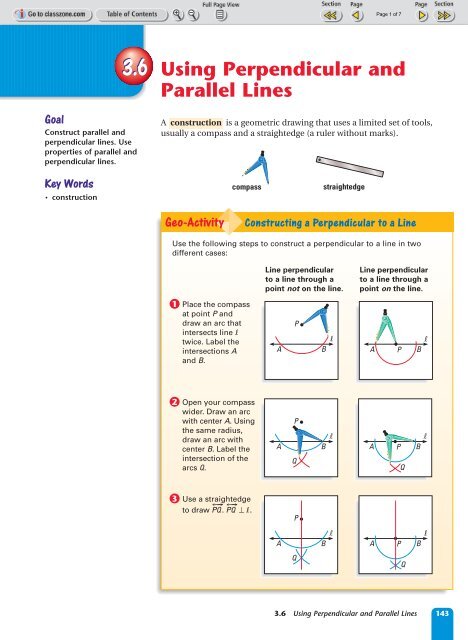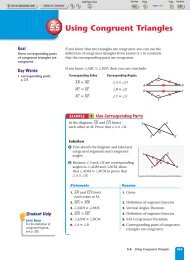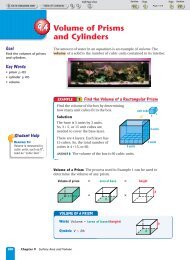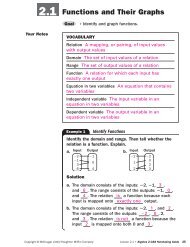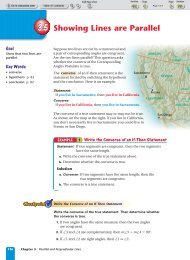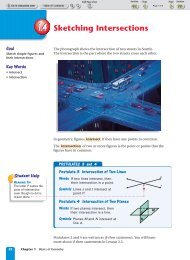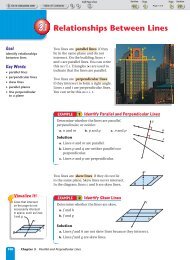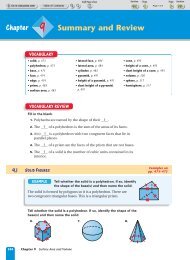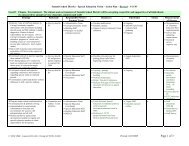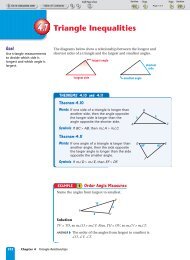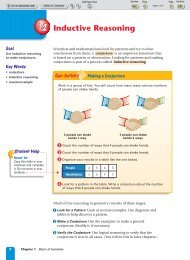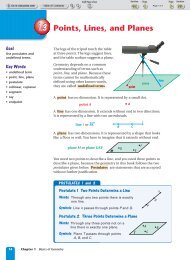3.6 Using Perpendicular and Parallel Lines
3.6 Using Perpendicular and Parallel Lines
3.6 Using Perpendicular and Parallel Lines
Create successful ePaper yourself
Turn your PDF publications into a flip-book with our unique Google optimized e-Paper software.
Goal<br />
Construct parallel <strong>and</strong><br />
perpendicular lines. Use<br />
properties of parallel <strong>and</strong><br />
perpendicular lines.<br />
Key Words<br />
p construction<br />
<strong>3.6</strong> <strong>Using</strong> <strong>Perpendicular</strong> <strong>and</strong><br />
<strong>Parallel</strong> <strong>Lines</strong><br />
A construction is a geometric drawing that uses a limited set of tools,<br />
usually a compass <strong>and</strong> a straightedge (a ruler without marks).<br />
Geo-Activity<br />
compass<br />
Constructing a <strong>Perpendicular</strong> to a Line<br />
Use the following steps to construct a perpendicular to a line in two<br />
different cases:<br />
●1 Place the compass<br />
at point P <strong>and</strong><br />
draw an arc that<br />
intersects line l<br />
twice. Label the<br />
intersections A<br />
<strong>and</strong> B.<br />
●2 Open your compass<br />
wider. Draw an arc<br />
with center A. <strong>Using</strong><br />
the same radius,<br />
draw an arc with<br />
center B. Label the<br />
intersection of the<br />
arcs P.<br />
●3 Use a straightedge<br />
to draw PP ^&*(. PP ^&*( ∏l.<br />
Line perpendicular<br />
to a line through a<br />
point not on the line.<br />
A<br />
A<br />
A<br />
P<br />
P<br />
P<br />
P<br />
P<br />
straightedge<br />
B<br />
B<br />
B<br />
l<br />
l<br />
l<br />
Line perpendicular<br />
to a line through a<br />
point on the line.<br />
l<br />
A P B<br />
l<br />
A P B<br />
<strong>3.6</strong> <strong>Using</strong> <strong>Perpendicular</strong> <strong>and</strong> <strong>Parallel</strong> <strong>Lines</strong> 143<br />
P<br />
l<br />
A P B<br />
P
144 Chapter 3 <strong>Parallel</strong> <strong>and</strong> <strong>Perpendicular</strong> <strong>Lines</strong><br />
EXAMPLE 1 Construct <strong>Parallel</strong> <strong>Lines</strong><br />
Construct a line that passes through point P <strong>and</strong> is parallel to line l.<br />
Solution<br />
●1 Construct a line perpendicular<br />
to l through P using the<br />
construction on the previous<br />
page. Label the line k.<br />
Construct <strong>Parallel</strong> <strong>Lines</strong><br />
P<br />
k<br />
1. Draw a line c <strong>and</strong> a point A not on the line. Construct a line d that<br />
passes through point A <strong>and</strong> is parallel to line c.<br />
POSTULATES 10 <strong>and</strong> 11<br />
Postulate 10 <strong>Parallel</strong> Postulate<br />
Words If there is a line <strong>and</strong> a point not on<br />
the line, then there is exactly one<br />
line through the point parallel to<br />
the given line.<br />
Symbols If P is not on l, then there exists<br />
one line m through P such that m l.<br />
Postulate 11 <strong>Perpendicular</strong> Postulate<br />
Words If there is a line <strong>and</strong> a point not on<br />
the line, then there is exactly one<br />
line through the point perpendicular<br />
to the given line.<br />
Symbols If P is not on l, then there exists one<br />
line m through P such that m ∏l.<br />
l<br />
P<br />
l<br />
●2 Construct a line perpendicular<br />
to k through P using the<br />
construction on the previous<br />
page. Label the line j. Line j<br />
is parallel to line l.<br />
P<br />
k<br />
m<br />
P<br />
P<br />
j<br />
l<br />
m<br />
l<br />
l
History<br />
CLIFF DWELLINGS were<br />
built mostly between 1000 <strong>and</strong><br />
1300 by Native Americans.<br />
The cliff dwellings above <strong>and</strong><br />
at the right are preserved at<br />
B<strong>and</strong>elier National Monument<br />
in New Mexico.<br />
THEOREMS 3.11 <strong>and</strong> 3.12<br />
Theorem 3.11<br />
Words If two lines are parallel to the<br />
same line, then they are parallel<br />
to each other.<br />
Symbols If q r <strong>and</strong> r s, then q s.<br />
Theorem 3.12<br />
Words In a plane, if two lines are<br />
perpendicular to the same line,<br />
then they are parallel to each other.<br />
Symbols If m ∏ p <strong>and</strong> n ∏ p, then m n.<br />
EXAMPLE 2 Use Properties of <strong>Parallel</strong> <strong>Lines</strong><br />
Ladders were used to move from<br />
level to level of cliff dwellings,<br />
as shown at right. Each rung on<br />
the ladder is parallel to the rung<br />
immediately below it. Explain<br />
why l p.<br />
Solution<br />
You are given that l m <strong>and</strong> m n.<br />
By Theorem 3.11, l n. Since l n<br />
<strong>and</strong> n p, it follows that l p.<br />
EXAMPLE 3 Use Properties of <strong>Parallel</strong> <strong>Lines</strong><br />
Find the value of x that makes AB ^&( CD ^&(.<br />
Solution<br />
By Theorem 3.12, AB ^&( <strong>and</strong> CD ^&( will be parallel<br />
if AB ^&( <strong>and</strong> CD ^&( are both perpendicular to AC ^&(.<br />
For this to be true aBAC must measure 90.<br />
(2x 2)90 maBAC must be 90.<br />
2x 88 Subtract 2 from each side.<br />
x 44 Divide each side by 2.<br />
ANSWER If x 44, then AB ^&( CD ^&(.<br />
q r s<br />
l<br />
m<br />
n<br />
m n<br />
A (2x 2) B<br />
C D<br />
<strong>3.6</strong> <strong>Using</strong> <strong>Perpendicular</strong> <strong>and</strong> <strong>Parallel</strong> <strong>Lines</strong> 145<br />
p<br />
p
Use Properties of <strong>Parallel</strong> <strong>Lines</strong><br />
Use the information in the<br />
diagram to explain why a c.<br />
2. 3.<br />
a b c<br />
You have now studied six ways to show that two lines are parallel.<br />
SUMMARY<br />
Corresponding Angles<br />
Converse, p. 137<br />
146 Chapter 3 <strong>Parallel</strong> <strong>and</strong> <strong>Perpendicular</strong> <strong>Lines</strong><br />
Find a value of x so<br />
that d e.<br />
d<br />
e<br />
(5x 10)<br />
WAYS TO SHOW THAT TWO LINES ARE PARALLEL<br />
Show that a pair of<br />
corresponding angles<br />
are congruent.<br />
Alternate Exterior Angles<br />
Converse, p. 138<br />
Show that a pair of<br />
alternate exterior angles<br />
are congruent.<br />
Theorem 3.11, p. 145<br />
Show that both lines<br />
are parallel to a<br />
third line.<br />
Alternate Interior Angles<br />
Converse, p. 138<br />
Show that a pair of<br />
alternate interior angles<br />
are congruent.<br />
Same-Side Interior Angles<br />
Converse, p. 138<br />
Show that a pair of<br />
same-side interior angles<br />
are supplementary.<br />
Theorem 3.12, p. 145<br />
In a plane, show that both<br />
lines are perpendicular<br />
to a third line.<br />
1<br />
2<br />
ma1 ma2 180
<strong>3.6</strong><br />
Exercises<br />
Guided Practice<br />
Vocabulary Check<br />
Skill Check<br />
Practice <strong>and</strong> Applications<br />
Extra Practice<br />
See p. 680.<br />
Homework Help<br />
Example 1: Exs. 22–24<br />
Example 2: Exs. 4–12<br />
Example 3: Exs. 19–21<br />
1. What are the two basic tools used for a construction?<br />
<strong>Using</strong> the given information, state the theorem that you can use<br />
to conclude that r s.<br />
2. r t, t s 3. r ∏ t, t ∏ s<br />
t r s r s<br />
t<br />
Logical Reasoning <strong>Using</strong> the given information, state the postulate<br />
or theorem that allows you to conclude that j k.<br />
4. j n, k n 5. j ∏ n, k ∏ n 6. a1 ca2<br />
j k<br />
n<br />
m<br />
n m<br />
Showing <strong>Lines</strong> are <strong>Parallel</strong> Explain how you would show that c d.<br />
State any theorems or postulates that you would use.<br />
7. 8. 9.<br />
n<br />
n<br />
112 c<br />
99 c<br />
112<br />
d<br />
10. c d 11. n<br />
12.<br />
c<br />
j<br />
k<br />
99 d<br />
n<br />
85 95 d<br />
j k<br />
1 2<br />
c d<br />
52<br />
52<br />
<strong>3.6</strong> <strong>Using</strong> <strong>Perpendicular</strong> <strong>and</strong> <strong>Parallel</strong> <strong>Lines</strong> 147<br />
n<br />
c d<br />
n<br />
116<br />
64<br />
m<br />
n
IStudent Help<br />
I CLASSZONE.COM<br />
HOMEWORK HELP<br />
Extra help with problem<br />
solving in Exs. 13–16 is<br />
at classzone.com<br />
Music<br />
GUITARISTS press their<br />
strings against frets to play<br />
specific notes. The frets are<br />
positioned to make it easy to<br />
play scales. The frets are<br />
parallel so that the spacing<br />
between the frets is the same<br />
for all six strings.<br />
Naming <strong>Parallel</strong> <strong>Lines</strong> In Exercises 13–16, determine which lines,<br />
if any, must be parallel. Explain your reasoning.<br />
13. p q r<br />
s<br />
14.<br />
80 100<br />
t<br />
15. a b<br />
16.<br />
c<br />
17. Guitars In the photo of the<br />
guitar at the right, each fret is<br />
parallel to the fret beside it.<br />
Explain why the 8th fret is<br />
parallel to the 10th fret.<br />
148 Chapter 3 <strong>Parallel</strong> <strong>and</strong> <strong>Perpendicular</strong> <strong>Lines</strong><br />
18. Visualize It! Make a diagonal fold on a piece of lined notebook<br />
paper. Explain how to use the angles formed to show that the lines<br />
on the paper are parallel.<br />
<strong>Using</strong> Algebra Find the value of x so that g h.<br />
19.<br />
(7x 13)<br />
g 20. g<br />
h 21.<br />
h<br />
(8x 10)<br />
9x <br />
d<br />
10th 9th 8th<br />
Constructions In Exercises 22–24, use a compass <strong>and</strong> a straightedge<br />
to construct the lines.<br />
22. Draw a horizontal line l <strong>and</strong> choose a point P on line l. Construct<br />
a line m perpendicular to line l through point P.<br />
23. Draw a vertical line l <strong>and</strong> choose a point P to the right of line l.<br />
Construct a line m perpendicular to line l through point P.<br />
24. Draw a horizontal line l <strong>and</strong> choose a point P above line l.<br />
Construct a line m parallel to line l through point P.<br />
a<br />
h<br />
g<br />
b<br />
j<br />
k<br />
g<br />
15x <br />
h<br />
x<br />
w
Student Help<br />
LOOK BACK<br />
For an example of<br />
boats sailing at an<br />
angle to the wind,<br />
see p. 104.<br />
St<strong>and</strong>ardized Test<br />
Practice<br />
Mixed Review<br />
Algebra Skills<br />
25. Sailing If the wind is constant, will the boats’ paths ever cross?<br />
Explain.<br />
26. Challenge Theorem 3.12 applies only to lines in a plane. Draw a<br />
diagram of a three-dimensional example of two lines that are<br />
perpendicular to the same line but are not parallel to each other.<br />
27. Multiple Choice Find the value of x so that m n.<br />
A 20 B 25<br />
C 40 D 90<br />
28. Multi-Step Problem Use the information given in the diagram<br />
at the right.<br />
a. Explain why AB&* CD&*.<br />
b. Explain why CD&* EF&*.<br />
A<br />
C<br />
1<br />
B<br />
100<br />
D<br />
100<br />
c. What is ma1? How do you know?<br />
Points, <strong>Lines</strong> <strong>and</strong> Planes Decide whether the statement is true<br />
or false. (Lesson 1.3)<br />
29. N lies on MK ^&*(.<br />
30. J, K, <strong>and</strong> M are collinear.<br />
31. K lies in plane JML.<br />
32. J lies on KL &(.<br />
wind<br />
Plotting Points Plot the point in a coordinate plane.<br />
(Skills Review, p. 664)<br />
33. A(2, 3) 34. B(1, 6) 35. C(4, 7) 36. D(2, 5)<br />
Expressions Evaluate the expression. (Skills Review, p. 670)<br />
37. 5 p 6 10 5 38. 8 33 14 39. 24 (9 3)<br />
45<br />
45<br />
40. 4(8 3) 2 12 41. 48 3 2 p 5 6 2<br />
(4x 10)<br />
42. [(1 8) 2 7] 8<br />
<strong>3.6</strong> <strong>Using</strong> <strong>Perpendicular</strong> <strong>and</strong> <strong>Parallel</strong> <strong>Lines</strong> 149<br />
m<br />
80<br />
E F<br />
J<br />
M<br />
K<br />
N<br />
n<br />
L


